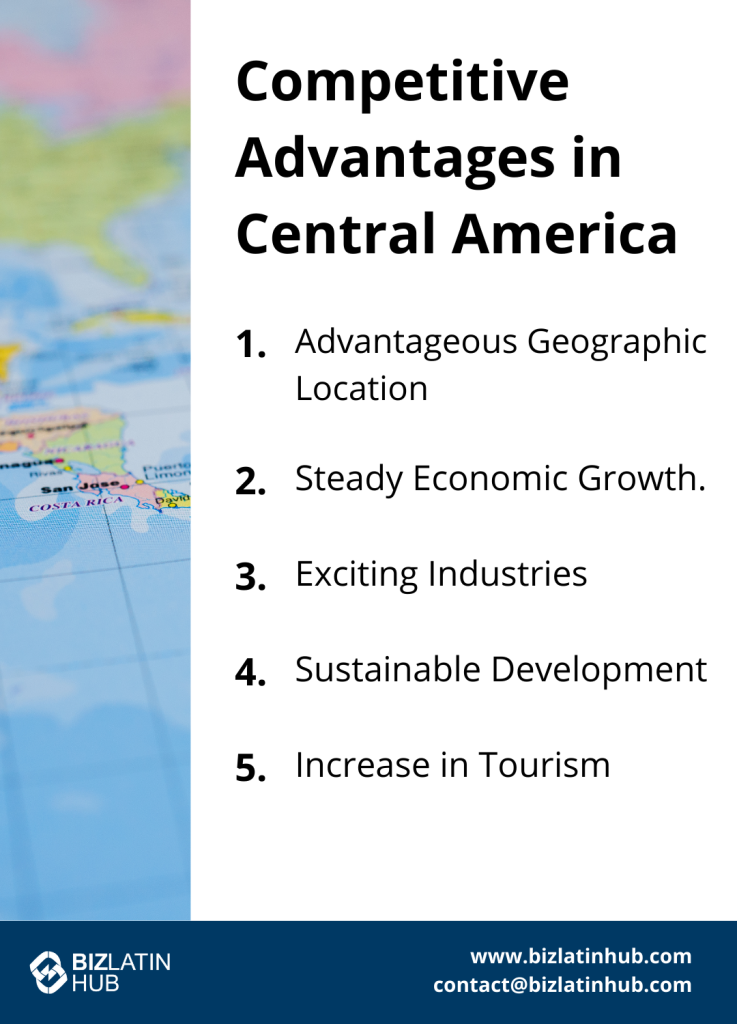This informative article will delve into trade and the economy in Central America, with a particular focus on Costa Rica. We spoke to Jairo Hernández, Costa Rica’s Ambassador to Australia for the article. He gave us an insight into the region’s business growth prospects in Costa Rica and Central America, offering valuable insights for investors and businesses alike.
From exploring trade dynamics to examining key economic indicators, our aim is to equip readers with the knowledge and understanding needed to navigate the evolving landscape and develop promising business growth prospects in Costa Rica and Central America.
Business growth prospects in Costa Rica and Central America remain strong all round. Comprising seven countries—Belize, Costa Rica, Panama, Guatemala, El Salvador, Honduras, and Nicaragua—with a collective population nearing 50,000,000, the region shares the Spanish language (except Belize) and borders, yet each country boasts unique cultural, historical, and business environments.
Overview of Business Growth Prospects in Costa Rica and Central America
Traditionally, Central America has not been the top choice for investment for individuals and companies looking to do business abroad. While Latin America has always had a fair share of investment, with countries like Chile and Peru excelling in the mining and METS industries, Central America has often missed out.
Although unknown to some, Central America is economically well-connected to the rest of the world, with a variety of free trade agreements, including but not limited to:
- United States-Central America-Dominican Republic Free Trade Agreement (CAFTA-DR).
- Central America-European Free Trade Agreement (EU-CAAA).
- Central American Common Market (MCCA).
These agreements provide a significant platform for facilitating the economic development of Central American economies. Since there are variations in production among countries in the region, strengths in production can be distinguished, allowing their economies to grow along with their trade and diplomatic relations.
Regarding the business environment, typically, Northern Central America tends to see significant reliance on its textile and agricultural industries, while unfortunately experiencing higher rates of poverty and progressing at a slower pace than the other countries. Southern Central America, specifically Costa Rica and Panama, have fairly advanced economies, with a shift in their economic models from exporting raw materials and textiles to the development and export of high-tech products, as well as significant growth in the service sector in Central America.
Investment and Business Risks in Central America
While we have a wide range of business growth prospects in Costa Rica and Central America available (which we’ll address later), unfortunately, investment risks still impact investor confidence and operations in the region. Business investment risk varies across the region; however, there are three key business risks in Central America that we have identified as the most influential on international investment.
Political and Economic Instability
While present in all regions, some countries in Central America experience higher levels of political and economic instability than others. The ‘Northern Triangle’ composed of Guatemala, El Salvador, and Honduras still experiences the repercussions of the civil wars of the 1980s, leaving behind violent legacies and fragile national institutions. Corruption and violence strongly impact investor confidence in the region, and despite developments, many investors still hesitate to consider these areas viable for doing business.
The region boasts many promising and attractive sectors, but for these to be optimized, reforms in political systems are necessary, and stability needs to be restored. If political systems and institutions can respond to the needs of the people and society, significant advancements can be achieved. Business growth prospects in Costa Rica and Central America hang on the effectiveness of such changes.
Geographical Location
The geographical location of Central America brings with it advantages. With easy access to both the Pacific and Atlantic oceans as well as the world-famous Panama canal, the region is a shipping hub. On top of that, the Panamerican Highway provides a good route into North America and there are strong trade links to large markets in South America.
Then of course, there’s the fact that the region is all in time zones that coincide with parts of the USA. This means that business growth prospects in Costa Rica and Central America benefit from straightforward communication. With doubts beginning to rise about Asian manufacturing hubs such as China, nearshoring also becomes a key part of Central America’s appeal to especially US-based companies.
5 reasons why business growth prospects in Costa Rica and Central America are appealing
There are a wide range of business growth prospects in Costa Rica and Central America and it’s not hard to see why.
- Advantageous Geographical Location.
- Steady Economic Growth.
- Exciting Industries and Sectors in Central America.
- Sustainable Development Sector in Central America.
- Rise in Tourism in Central America.
1. Advantageous Geographical Location
The natural bridge between North and South America provides Central America with a strategic competitive advantage in terms of international trade. Its geographical position combined with well-thought-out free trade agreements is repeatedly demonstrated as a significant trade advantage. The Panama Canal has brought huge benefits to the region, with some experts saying that we have not yet seen the full potential of the Canal, and trade between Asia and the East Coast of the US is expected to grow. The Panama Canal offers a significantly shorter route for Asian and American traders compared to the Suez Canal in Egypt.

2. Steady Economic Growth
While a small number of regions are expected to face economic troubles in 2018, the region as a whole is expected to experience solid economic growth. Growth in 2024 is expected to reach 3% expecting an increase to 3.3%. Countries like Panama and the Dominican Republic are expected to experience the highest rates of economic growth in the region. Another country to mention is Guatemala, which despite economic and political struggles, is seeing promising GDP growth and an increase in household spending.
3. Exciting Industries and Sectors in Central America
Latin America as a whole has seen the strengthening of traditionally dominant sectors, such as the Mexican automotive industry, to new sectors like unconventional renewable energy in Chile and e-commerce in Argentina. While South America has typically developed at a faster pace than Central America, the region as a whole boasts a number of interesting industries and sectors. From the traditionally strong markets of textiles and agriculture in northern Central America to the service-based technological sectors in Costa Rica and Panama, the region is witnessing the growth of business opportunities for both locals and foreigners.
Costa Rica, the hub of innovation for technology, is experiencing a significant boom in the service industry. The country’s highly educated and bilingual English and Spanish population, along with its welcoming business environment, has made the country an attractive destination for foreign tech companies. Another exciting and developing country is Nicaragua, which also has a young and educated workforce. Many foreign companies have found that doing business in Nicaragua enhances their global competitive advantage by reducing human capital costs while maintaining high-quality control.
4. Sustainable business prospects in Costa Rica and Central America
Central America has great potential for foreign investment in the sustainable development sector, with a number of projects in the renewable energy sector, especially wind, solar, and hydroelectric. Although the region is not recognized for its efficiencies in renewable energy, it has many competitive advantages, one of which is its participation in non-renewable hydroelectric energy. This is an impressive 13% of supply compared to the global average of 5%.
“Costa Rica’s commitment to sustainability is no accident,” says ambassador Jairo Hernández, “The country has been without an army since 1949, and this has had an obvious impact on its human development indicators. Costa Rica has an advantage in terms of biodiversity and an economy driven by masses of tourism (and ecotourism) thanks to its pristine environments and untouched natural beauty. Sustainable development, with three key pillars in action: economy, society, and environment, is part of the soul of a country that allows it to enjoy freedom and peace.”
5. Rise in Tourism in Central America
As the world embraces travel like never before, many people are looking for new destinations. Central America has skyrocketed onto the tourism map in the last decade, and this trend is expected to continue. Great weather, many coastlines, affordable prices, and friendly people have meant that the tourism industry is reaching its peak. This industry growth creates openness for much-needed investment in the sector (often from abroad).
In Costa Rica, tourism has surpassed agriculture as the country’s largest industry, with eco-friendly and sustainable accommodations nestled in beautiful forests and parks. Additionally, in the past two years, new airlines have opened direct services to Costa Rica from cities like London, Paris, Amsterdam, Zurich, Frankfurt, and Munich. This means more tourism business prospects in Costa Rica and Central America as a whole.
What Does the Future Hold for Central America?
Jairo Hernández envisions a promising future for Central America. He is aware that the region is not without its challenges; however, the overall outlook for the region is promising. Hernández sees five vital areas that will create opportunities for advancement in the country.
- Increasing the importance of the education sector.
- Transformation of political systems.
- Greater openness of economies to foreign participation and expansion of economic relations.
- Adopting a forward-thinking mindset (looking 10-20 years ahead instead of just the next elections).
- Creating conditions to encourage sustainable development.
As the region develops, investment opportunities increase, positively contributing to local economies and ultimately to the lives of the inhabitants. The region as a whole has seen the benefits brought by foreign investment. Central America, similar to Latin America as a whole, has an exciting future ahead, and through the development and implementation of policies mentioned above by Mr. Hernández, the countries spanning the region have the opportunity to thrive and develop.
Ambassador Jairo Hernández says that “Central America remains a highly privileged geographical area that connects the northern and southern parts of the Americas. Virtually without exception, countries are committed to attracting foreign investment in various forms, and the region is already seeing the benefits that this investment brings them.”
He goes on to say that “Being a region composed of small countries has many advantages; there is great potential for growth and investment in various projects including public infrastructure, manufacturing businesses, tourism, and services. Privileged by nature, this part of the world is a potential laboratory for sustainable development practices that make sense from a business perspective.”
Need help with your business growth prospects in Costa Rica and Central America?
Get in touch with a member of Biz Latin Hub and see how we can facilitate your business growth prospects in Costa Rica and Central America. More and more foreigners are looking outside traditional markets for attractive places and sectors to do business, and Latin America controls all markets. Contact us for more information.
Our team of qualified and multilingual professionals in Latin America offers a range of personalized market entry and back-office services to support your expansion. Contact us now, visit our website at bizlatinhub.com for more information, and become part of the Central American business landscape.
Learn more about our team and expert authors.
Interested in investing in other promising sectors? Watch this video and learn about investment in Colombia, one of the most exciting developing countries in South America.





